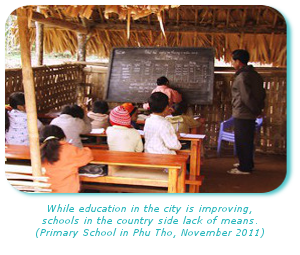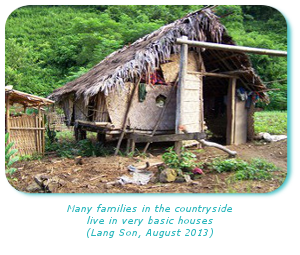The Vietnamese names
In Viet Nam, people’s names are usually constituted of 3 or 4 parts. Let’s take the example of my maiden name:
Nguyên (Family name) Thi (middle word) Luân (First name)
Over 300 family names exist in Viet Nam, but the most common ones are the Nguyen, the Tran, Le, Pham, Ngo, Dinh and Hoang.
The middle word usually shows gender: very often Thi for women and Van for men. There may be a second middle word but it is becoming rarer nowadays.
Finally, the first name remains very imaginative. Women are often named after a bird, a flower or poetic concepts. Men, on the other hand, are often named after a virtue (braveness, strength, intelligence…)
When you address to someone, it is customary to use honorific word: chau (baby), em (little brother, little sister), anh (big brother), chi (big sister), etc…followed by that person’s first name.
We cannot use a first name without that honorific word, it is the reason why Vietnamese people will use Mr or Ms in front of your name to call you…They are uncomfortable using your first name alone.
To call out for someone, we will always use the syllable ‘’oi’’ after that person’s first name, marking the interjection.
The family organization
 In Viet Nam, family is sacred! The people within our homes are often very united, based on the respect of the elders. It is part of the Confucian logic.
In Viet Nam, family is sacred! The people within our homes are often very united, based on the respect of the elders. It is part of the Confucian logic.
Parents take care of children and children give respect and obedience to their elders. Similarly, elderly people are particularly well respected in Viet Nam…and even beyond their death with the cult of ancestors! One also needs to understand that the lack of retirement system reinforces the devotion of the children towards their parents, indeed the latter are living at their own expense passed a certain age, which is at the opposite of the modern Westerners systems.
Education

Inequalities are big between the city and the countryside. Country’s infrastructures are indeed largely insufficient, and that is without mentioning the fact that numerous children are working in the fields starting from age 13 or 14. In the city, however, schools are moderns, numerous and don’t lack in educational tools.
Primary, Secondary and High schools follow the French model. However, few are the people having access to higher education: once the High school exam passed, the Vietnamese students have to pass highly competitive exams in order to get in public universities, but the places are expensive!
The number of private schools is increasing. Getting in also requires competitive exams and files, but the student has lesser choice about his submissions of application. Those schools are very expensive: they represent over one third of a family budget. In that way, it is unfortunately not uncommon to notice that only the firstborn is send to school.
The role of woman
I do not want to sound more feminist than I already am but women are essential in Viet Nam: they are the guarantors of the Country’s unity.
Indeed, Vietnamese people consider that each woman has to gather four fundamental virtues: taking care of the house, being beautiful, virtuous and talking softly. In addition to taking care of the house, the family budget and children’s education, it is women who give agreement to weddings, and it is women again who get up first to prepare breakfasts, lunches and family diners! They sometimes complement the husband’s incomes with small local businesses and are always the one doing the tiresome works in rural areas: pricking out rice, taking care of the vegetable garden and the farmyard, selling domestic products…
Even if they are pulling the strings from behind, women have little right in society. A lot of examples may shock foreigners: during receptions they eat separately from the guests, they do not contradict their husband, etc… Moreover they do the most tiresome labors: in construction companies for example, it is generally women who carry the bricks while the bricklayer calmly waits on his chair!
Houses and dwellings
Houses in Viet Nam can differ greatly depending on: whether you live in the countryside or the city, on the family’s wealth or yet on which ethnicity you belong.

In rural area, houses can be made of bamboo, cob, clay bricks or concrete. Roofs can be elaborated from thatch, palm tree leaves or even clay tiles. The house is almost always surrounded by a vegetable garden and a concrete yard where harvests of rice, corn, manioc or peanut can dry by the sun. It is also pretty common to see that the kitchen is separated from the housing area and the farming property. The number of rooms of the house depends mostly on the level of wealth of the family, but usually it comes down to one big room serving as both living room and bedrooms.
In urban area, the extreme population density is exerting a strong pressure on land access. The architecture of Vietnamese houses is thus under that influence. Houses facing main streets are limited in façade surface (the only painted side of the house) as well in floor space; they are built in depth and in height! From 4 to 5 floors high (the ground floor does not exist in Viet Nam: it is equivalent to the first floor), the houses shelter entire families, from elders to small children.
Only little individual housings exist, such as apartments or studios, which are rather expensive in comparison to renting a house. It is not uncommon that several students share vacant rooms from city families whose children left either to study or work elsewhere. Nowadays, some areas of ‘’Western architecture’’ are in construction in big cities, presenting the first condo towers of twenty floors tall.




